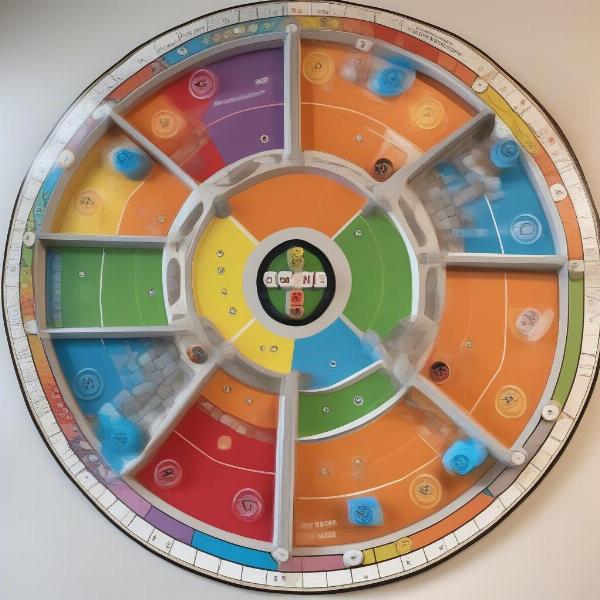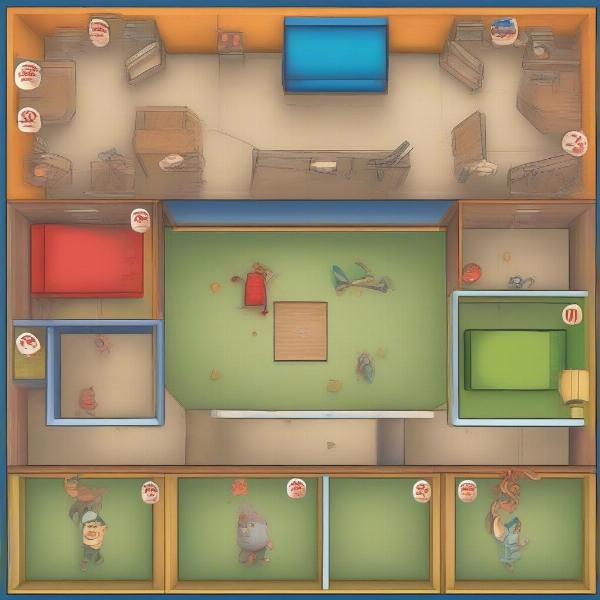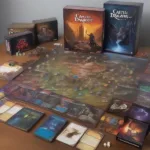Trouble is a classic board game known for its iconic Pop-o-Matic dice popper and fast-paced gameplay. Its simple rules make it a great choice for families and players of all ages. But even with its simplicity, there are still some nuances to understand. So, What Are The Rules For The Game Trouble? Let’s dive in and explore everything you need to know to play.
Understanding the Basics of Trouble
The objective of Trouble is to be the first player to get all four of your pegs around the board and safely into your “Home” row. The game board features a circular track with spaces for pegs, a central Pop-o-Matic bubble, and four Home rows for each player.
How to Play Trouble: A Step-by-Step Guide
- Setting Up: Each player chooses a color and places their four pegs in their corresponding starting area.
- Rolling the Dice: Players take turns pressing the Pop-o-Matic bubble to roll the die. The number rolled determines how many spaces a peg can move.
- Moving Your Pegs: On your turn, you can move one of your pegs the number of spaces indicated by the die roll. Pegs move clockwise around the board.
- Landing on an Opponent’s Peg: If you land on a space occupied by an opponent’s peg, you “send” their peg back to their starting area. This is one of the most exciting parts of Trouble!
- Safety Zones: The starting areas and Home rows are considered “safe zones,” meaning pegs in these areas cannot be sent back.
- Entering the Home Row: To enter your Home row, you must roll the exact number needed. If you roll a higher number than needed, your peg “overshoots” and must continue moving around the board on your next turn.
- Winning the Game: The first player to get all four of their pegs into their Home row wins the game.
 Trouble Game Board Setup
Trouble Game Board Setup
Special Situations and Rules Clarifications
- Rolling a 6: Rolling a 6 allows you to move a peg out of your starting area and onto the board. It also grants you another turn. If all of your pegs are already on the board, you can simply move a peg six spaces.
- Blocked Spaces: If your peg’s movement is blocked by another peg (either your own or an opponent’s), you cannot move that peg. You must choose a different peg to move, if possible.
- No Legal Moves: If you have no legal moves available, your turn is forfeited.
Strategies for Winning at Trouble
While Trouble is largely a game of chance, there are some strategies you can employ to increase your odds of winning:
- Aggressive Play: Prioritize sending your opponents’ pegs back to their starting area whenever possible. This can significantly delay their progress.
- Defensive Play: Focus on getting your pegs into your Home row as quickly as possible, even if it means sacrificing opportunities to send opponents back.
- Strategic Blocking: If you have multiple pegs on the board, try to position them strategically to block your opponents’ movement.
“In a fast-paced game like Trouble, being opportunistic is key. Don’t just focus on your own pegs; always be looking for chances to disrupt your opponents,” advises veteran board game enthusiast, Amelia Carter.
Variations and House Rules
Many families and players have developed their own house rules for Trouble, which can add variety and excitement to the game. Some common variations include:
- Double Trouble: Rolling doubles allows you to move two pegs instead of one.
- Bonus Moves: Landing on certain spaces grants bonus moves or special abilities.
- Team Play: Players can team up and work together to get all of their pegs home.
 Trouble Game Variations and House Rules
Trouble Game Variations and House Rules
Why Trouble Remains a Beloved Classic
Trouble’s simple rules, fast-paced gameplay, and element of chance make it a timeless classic. It’s a game that can be enjoyed by players of all ages and skill levels. “Trouble’s simplicity is its strength. It’s a game that everyone can pick up and play immediately, but there’s still enough strategy involved to keep it interesting,” notes game designer, David Miller. The Pop-o-Matic bubble also adds a unique and satisfying tactile element to the game. Whether you’re looking for a quick family game night activity or a fun way to pass the time with friends, Trouble is a game that’s sure to provide plenty of laughs and friendly competition. So grab a board, press the Pop-o-Matic, and get ready for some Trouble!
Exploring Similar Dice-Rolling Board Games
If you enjoy Trouble, you might also like other dice-rolling board games like Parcheesi or Sorry! They share similar mechanics of moving pegs around a board and sending opponents back to their starting positions, but each game offers its own unique twists and challenges. Similar to how to watch chiefs game without peacock, these games offer a blend of luck and strategy, providing an engaging experience for players of all ages.
Conclusion
Trouble is a classic board game with straightforward rules that are easy to learn. The game’s fast-paced action and the thrill of sending opponents back to their starting areas make it an engaging and entertaining experience for players of all ages. Whether you’re a seasoned board game enthusiast or a casual player, understanding the rules of Trouble will ensure hours of fun and friendly competition. So, gather your friends and family, roll the dice, and get ready for some Trouble!
FAQ
- How many players can play Trouble? Trouble can be played by 2-4 players.
- What happens if I roll a number higher than needed to get my peg into Home? Your peg “overshoots” and continues moving around the board on your next turn.
- Can I move more than one peg on my turn? No, you can only move one peg on your turn, unless a house rule or variation allows otherwise.
- Can I capture my own pegs? No, you cannot capture your own pegs.
- What happens if the Pop-o-Matic doesn’t work? You can use a regular six-sided die as a substitute.
- Is there a way to strategize in Trouble? While Trouble is largely based on luck, strategic blocking and aggressive gameplay can increase your chances of winning.
- Where can I buy the game Trouble? Trouble can be purchased at most toy stores, department stores, and online retailers.

